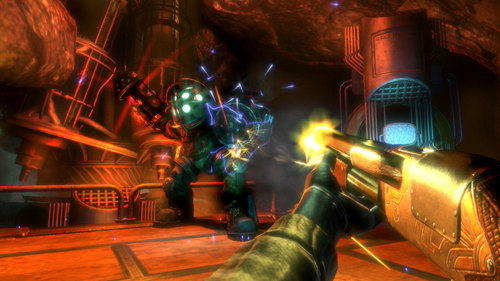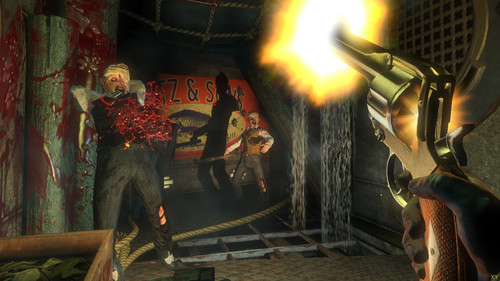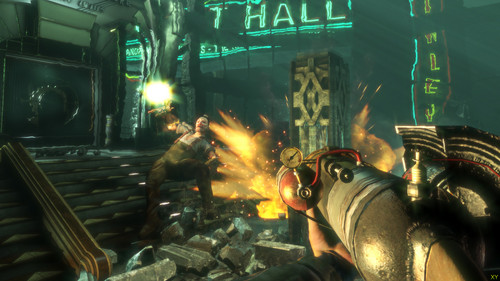As many of you probably know. System Shock 2 is my favorite game of all time. The game was absolutely revolutionary at the time and went on to inspire other games such as Deus Ex. System Shock 2 was a horror first person shooter RPG hybrid and is considered by many to be one of the scariest (if not the scariest) games ever created. Bioshock, the spiritual successor to System Shock 2 is being developed by essentially the same team. So you could imagine my excitement when I heard about it.
And I am certainly not the only one excited. There is a huge amount of hype surrounding this game. Bioshock won 17 awards at E3 this year, including Best of Show by GameSpot, GameSpy and IGN. Many are expecting this game to be pretty unique and innovative, and I have no doubt that Irrational Games will deliver.
Check out this great article on Bioshock that CGW did back in May:
A dark illimitable ocean, without bound, without dimension, where length, breadth, and height, and time and place are lost. –John Milton, Paradise Lost
It begins in fire. Gut-wrenched and water-blind, you struggle up through the wreckage of your plane. Questions hit your brain like grenades. Where are you? What caused the crash? In the near distance, a lighthouse stabs the sky. A lighthouse in the middle of the ocean? You swim toward the improbable structure, crawling from the water and clambering up its spiral staircase. At the pinnacle, a bathysphere hangs suspended from thick steel cabling.
Bewildered, but curious, you climb into the deep-diving chamber and–nowhere else to go–trigger your descent into the blank water below. You can see the tail section from your plane sinking slowly in the distance as the light above fades. A video screen warbles to life and a voice speaks: something about a secret utopia, an ocean-bottom city populated by the world’s elite. You try to follow, but it’s garbled, and as it finishes, you’re left in murmuring blackness, except for…a billboard? Emerging outrageously from the inky murk, a smiling, four-color bombshell pitches a brand of cigarettes: Oxford Club (“For Discriminating Tastes, No Compromises!”). Agog, you pass beneath the floodlit poster and emerge above a turquoise metropolis plunging into sunless depths. Welcome to the Garden of Eden at the end of the world…welcome to Rapture.
Son of Shock
At the turn of the century, Boston-based Irrational Games (Freedom Force, SWAT 4) released a sequel to defunct developer Looking Glass Studios’ 1994 “immersive first-person 3D” game, System Shock. Interface-nuanced and memorably ambient, System Shock 2 failed to score in the mass market, but pundits gushed anyway, a few even placing it on “best of all time” lists. Why? Forget gravity guns and bullet-time reflexology; the Shock series reflected filmic notions that psychological terror trumps reckless run-and-gunnery. Its lesser commercial success remains one of history’s mysteries (overly complex interface? Or just undermarketed?), but anyone who’s played it understands: Shock 2 was grab-your-ankles scary, and pulled it off without having to go “boo.”
Enter BioShock (not the long-hoped-for System Shock 3–Electronic Arts owns the rights to the series). System Shock 2 creative director and Irrational founder Ken Levine says he’s been kicking around a “spiritual” sequel to the Shock series forever. “The specifics were pretty different originally, but the intentions were always the same,” he explains as we sit in a room surrounded by dim pictures of light-riddled underwater buildings. “And by that, I mean engaging the next step of immersive gameplay, to have more choice and expression and to really look at the next big thing with A.I.”
Challenging SOE chief creative officer Raph Koster’s recent assertion that the single-player game is doomed, Levine thinks it’s barely cleared the womb. “We were saying, ‘OK, we can make A.I. that does all the traditional A.I. stuff–flanking, audio smarts, communication.’ But we didn’t know where else to go,” says Levine, sitting forward in his chair and smiling. He’s about to talk up his favorite subject, emergent gameplay, aka “players coloring outside designer lines.”
“We started looking at A.I. that had relationships,” he says, referring to the system at the technical core of BioShock, “A.I. that had a web of motivations, which would result in behavior that would be very understandable to the player, A.I. capable of evoking complex emotional responses.” If multiplayer games are chat-a-rific at the expense of thematic complexity, thematically rich (by comparison) single-player games often fail to meet players’ demands for socially insightful spontaneity. Levine’s thoughts precisely. “We really want the player to make moral decisions that aren’t habitual,” he says, referring to rooms full of scripted bad guys with artificially poignant ethical “choices”–like the option to off friendlies or to blitz bystanders via jacked cars, and its purely one-dimensional consequences. “We want the choices players make to [have an] impact in more than just some superficial or statistical way. Usually, the advantages of doing evil are a lot clearer than the advantages of doing good, and we wanted to thread that tension through BioShock by creating a multiform A.I. ecology that exists and acts persistently, completely independent of the player.”
Which leads us back to our dim Art Deco metropolis at the bottom of the ocean, the ideologies of Ayn Rand and Adam Smith.the fabled city of Rapture.
In Arcadia, I Am
“Watch it; that’s a security camera,” warns Levine, standing just behind my left shoulder as we gaze at one of Rapture’s damaged rooms. Shadows swing pendulous over seawater-scoured terrazzo flooring, sepia lights fizz and flicker, and a battered travel board, half-numbered and glow-lit, hangs askew below a crenellated archway. The ocean whispers in groans and rasps as it presses stoically against cobalt glass portals. My eyes shift to an elliptical device on the ceiling panning back and forth. “You can search pretty much anything,” says Levine, pointing to cash registers and office furniture. And bodies, of course. We’re looking for bullets. “OK, have a go at it now.” The view rushes forward, dipping toward a corner of the floor and a fetal human form, but too slow–the sudden hammer-clang of an alarm bell sounds, and almost immediately the air is filled with buzzing, bobbing security drones. “Crap, spotted…get us out of here,” warns Levine, and the view spins, angling toward another room down a dim, water-soaked hall.
The city of Rapture looks like a Nick Gaetano painting made into a David Lynch film. I comment that the alarm bell sounds like an old phone ringer. “Analog, analog, analog,” says Levine, referring to the game’s retro, Art Deco look and feel. “Art Deco is like the utopian architecture of the future, and it’s great for 3D architecture because it’s very polygonal–big bold shapes, basically Randian ideology in the flesh.” For readers unfamiliar, Atlas Shrugged author Ayn Rand was an expatriate Soviet writer whose hatred of Communism spawned polemical treatises like Capitalism: The Unknown Ideal. In Rand’s view, selfishness is virtuous, the rational dissembles the religious, and “man-worship,” i.e., veneration of an ideal unfettered individual, is all.
In BioShock, an ex-Soviet named Andrew Ryan comes to America in the 1940s and succeeds as a wealthy industrialist–the essential Randian hero. “But he sees what’s happening in America in terms of reactions to Stalinism and the advent of large-scale nuclear weapons,” explains Levine. “And having just been through World War II, he says, is this really viable? Or am I going to go off from the looters and bring the best and the brightest with me, to survive not just physically but spiritually?”
Thus, in 1946, Ryan and several thousand others secretly create the city of Rapture at the bottom of the ocean as a haven for the physical and intellectual elite. “But it’s not going to be like The Abyss,” notes Levine. “It’s not merely industrial. Basically these guys go down and their attitude is, ‘F you to God; we’re going to build not just a city, but the best city ever, the best artists, the best athletes,’ and so on. Not just something huddled under the freezing ocean.” In other words, Babel below.
“Rand was an ideologue; everything had to fit into her ideology–likewise Ryan. And BioShock is about the dangers of extreme ideology,” says Levine, referring to, among other things, the superimposition of human morals onto amoral ecosystems. “When nothing matters but the market–whenever you make anything everything–you have horror.” Levine describes the city of Rapture as a glorious accomplishment, a true capitalist society with the whole range of socioeconomic structures. “You’ll see different types of ads: For instance, the low-end brand of cigarettes is called Nico-Time, the bad whiskey’s called Old Tar, and so on,” he says, noting that every detail in Rapture will be deliberate and story related. “But let’s just say the ocean’s not happy about having a utopia sitting in its midst. The ocean has something to say about that.”
Over the course of a decade, Ryan crafts Rapture in his own image, a city of ideological extrapolations within which he will not compromise. “He has to be right,” adds Levine, his voice lowering. “So even as the world of Rapture falls apart, he draws closer to his ideology. And the tragedy–the horrible tragedy–is that they almost get there. They almost succeed.”
Gene Wars
As we leave the drones and pass through an ornamental hallway, overstressed metal sobs in staccato, and water claws greedily at the outside skin of the city. The ocean is returning to Rapture. Starfish cling like five-fingered barnacles to the outsides of windows, and fish shadows dart along blood-stained wood flooring. Bodies rest in corners or tumble down stairs like rag-doll statues. The city feels empty, desolate, yet insanely alive, a tumor-snaked patient on a ventilator. What happened here?
“As Ryan’s society is flourishing, a group of scientists discover this deep-dwelling sea slug that essentially excretes raw stem cells,” explains Levine, referring to the very real and recently news-grabbing group of cells with the potential for major organ repairing or growing. “And a man named Fontaine, who is this very slick, very sharp guy, identifies this and uses his wiles to get in with these nerdy scientists that are doing it for the science, not the money.”
While Ryan has a virtual economic monopoly, Fontaine releases refined versions of this substance–dubbed “Adam”–into the system, and it quickly becomes the de facto currency, pitting Fontaine against Ryan. “Want to be healed? Smarter? Better looking? Bench-press 200 pounds?” says Levine. “It quickly gets out of control, and Ryan, man of principles, interestingly decides to use whatever governmental power he has to break up Fontaine’s trust. But by the time he moves, it’s already too late.”
Levine describes an army of people jacked up on Adam with superhuman abilities–when Ryan tries to stop Fontaine, it’s all-out war. “In all war, there’s talk about principles and noble rhetoric, but it’s essentially just economics,” says Levine. “And this war starts on New Year’s Eve and pretty much destroys Rapture by turning survival into a miniature genetic arms race.” People use Adam just to stay alive, feeding on more and more of the raw substance so that at the war’s tragic close, when Ryan finally wins, the victory comes at a terrible price: Everyone’s dead.or no longer human.
Monsters of the Deep
“Years have gone by since the war ended when you arrive,” says Levine. “And you discover pretty early on that you’re not alone, that something terrible happened and may still be happening.” Cue BioShock’s creature caste, a three-way ecology of predators and prey that interact dynamically whether you’re in the vicinity or not. Think about all those Animal Planet shows about gazelles and lions and hyenas, then imagine behavioral A.I. that’s like tossing all three into a closed environment. “We call it an A.I. ecology because there are all these ways to interact with and even exploit the system,” adds Levine.
Middle-food-chain “monsters,” aggressors are the ragtag remnants of Ryan’s mutant army and possibly the most populous in the city. Hunting for remnants of Fontaine’s people, aggressors will attack on sight and can do crazy things like perform backflips or spring spiderlike between floor and ceiling. Based on art by original System Shock artist Rob Waters, the final models promise to be chilling. “These are people who used to be normal. But when things fell apart, they used Adam to stay alive, which of course altered their appearance,” explains Levine. “Some even wear masks, and there’s always something creepier about a mask than what lies underneath. The thing about covering it up is, they’re ashamed about it, but they did what they had to do to survive.”
Arguably the most disturbing of the bunch, gatherers exist to harvest Adam from dead bodies. “The gatherers are exploited children,” explains Levine. “Because they’re still growing, they have a genetic component necessary for recycling Adam. Since the original sources of Adam are gone, the gatherers take Adam from the dead. They do something to it and get a substance that gives [them] special powers and abilities.” Imagine a malnourished, bedraggled girl emerging from a high-up wall duct in one of Rapture’s rooms. On the other side, a dead body rests slack-jawed against a wet bar. A tremulous falsetto croons some ancient 1930s love song from invisible speakers and a spotlit poster on the far wall reads “Fontaine Dandy Dentures!” The girl–a gatherer–crouches in the opening, waiting, until a metallic whir fills the air, growing louder and clearer until something huge and cyclopean clomps into the room: a deep-sea diving suit, almost too wide for the corridor it’s standing in, with Gatling guns for arms.
The gatherer beckons to this creature–a _protector (Levine refers to them as “big boys”)–and it shambles obediently over. The gatherer hops nimbly onto the protector’s back, and the pair shuffle to the other side of the room, where she climbs down and kneels before the dead body. Drawing a syringe from her pack, the gatherer raises, then slams it, Pulp Fiction- style, into the body’s chest, drawing priceless Adam from its desiccated frame. Moments later, she raises the device to her mouth and drinks deeply. Where she goes next with her precious internal cargo–and why–is one of the game’s top secrets.
When you encounter gatherers, they’ll always be in the company of a protector (aggressors avoid both of these types religiously). Attack either, or get too close to a gatherer, and you’ll be in for the fight of your life. Levine mentions unscripted situations where–based on ecology-determined spawning heuristics and whatever physical state you’re in–you may be forced to make agonizing ethical choices. If it looks and acts like a child, would you kill it, even to stay alive? “BioShock is about asking the questions: What would you do to survive? How far will you go?” says Levine. “You have to make the same kinds of choices these people had to make. And how this reflects on you…” Levine smiles knowingly, “let’s just say we have ways of playing with that theme.”
– Computer Gaming World, May 2006
Sounds pretty cool right? Whats even better is that Irrational Games just released 14 minutes of ingame footage from Bioshock. This is the first footage the public has been able to see. You can find the video here.




